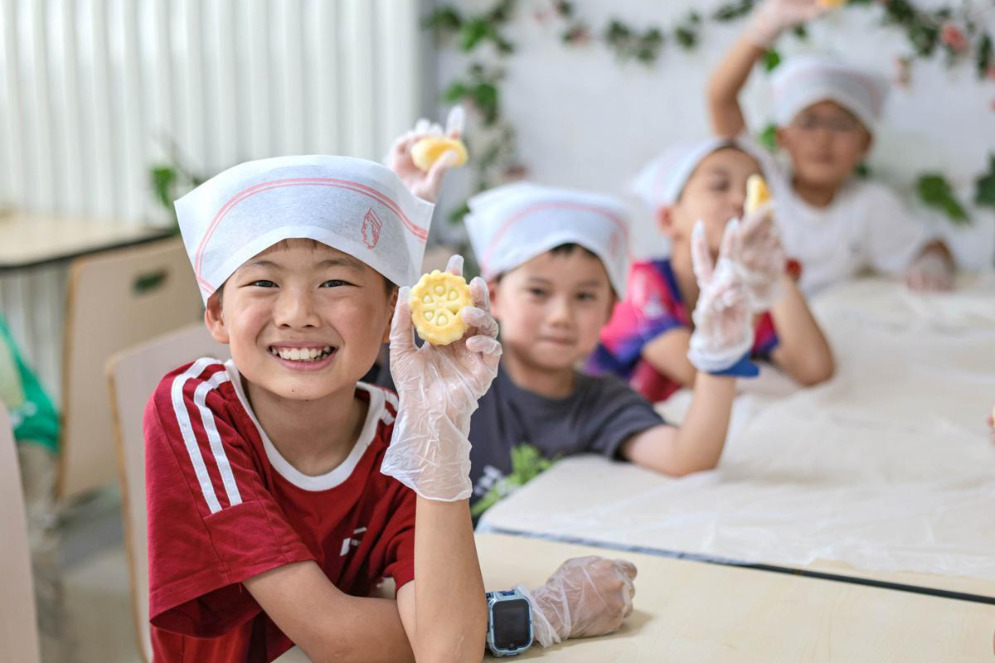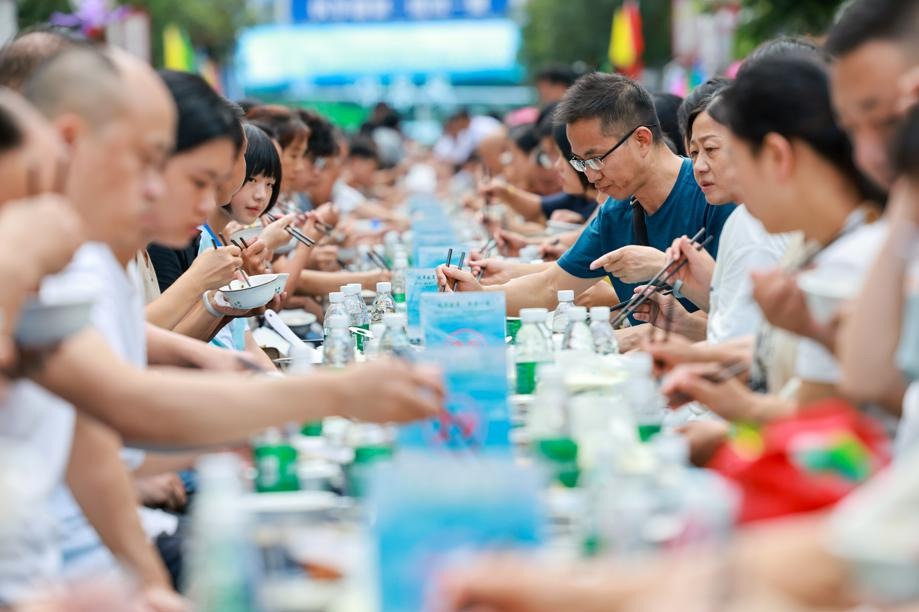Year of the Rabbit sees much-loved creature hop onto center stage


Legend of friendly, furry animal deeply rooted in folklore
A new stainless-steel sculpture, named Two Rabbits, created by renowned artist Yuan Xikun, was unveiled at the Solana Mall in the capital's Chaoyang district in January. Hundreds of people took photos of the sculpture, especially with children in the frame.
Yuan, founder of Beijing Jintai Art Museum, has been designing this rabbit sculpture since the beginning of 2022. He has created 12 Chinese zodiac signs, but all in single form, and this time he chose to design a pair of rabbits because in Chinese culture even numbers have an auspicious meaning.
"I want to use the sculpture to express my wishes that everyone is happy and healthy in the new year, as the rabbit is a sign of safety and good health in Chinese culture," Yuan says.
Under the Chinese zodiac, 2023 marks the Year of the Rabbit. In China, people's lives are associated with elements of the animal whether his or her Chinese zodiac sign is a rabbit or not. They may wear rabbit-shaped hats or shoes after birth, play with rabbit-shaped lanterns or a Tu'er Ye (the rabbit god) toy, or eat rabbit-shape snacks or steam buns.
The rabbit, which is a translation from the Chinese character tu, ranks fourth among the 12 animals of the zodiac, coming in after the rat, ox and tiger. The fourth name of the 12 Chinese zodiacs is maotu, and mao means the time between 5 am and 7 am.
According to Hou Yangjun, deputy secretary-general of the Chinese Folk Literature and Art Association, the ranking of the 12 zodiacs is related to the animals' living habit.
"In folklore, the rabbit has the habit of getting up early and likes grass, spring and the sunshine in the morning, so it is linked with mao, the early time of a day in the 12 zodiacs," Hou says.
The rabbit is quite popular in Chinese folk culture as it's a deft and cute animal that can jump high and climb with agility. In folk crafts, whether in embroidery, paper-cutting, clay sculpture or dough modeling, rabbits are often depicted.
"People like the rabbit as it has the symbolic meaning of fast development and being promoted step by step," Hou says.
Folklore says the jade rabbit on the moon is transformed from Chang'e, a Chinese moon goddess, meanwhile some believe that Chang'e flew to the moon with the jade rabbit.
According to Hou, it is widely believed that the earliest record of linking the rabbit and the moon is from Qu Yuan's poem Tianwen("questions to heaven"), yet some scholars think Qu was referring to the toad.
"The feature of folk culture is that the folklore differs in different regions, and the oral-spread legend and the stories recorded on historical classics are just part of them," Hou says.
Elixir maker
In the mindset of the ancient Chinese, apart from dexterity, the rabbit was an auspicious animal who created an elixir for longevity.
Evidence of such a tale can be found in many relics, such as on the tomb portraits from the Han Dynasty (206 BC-AD 220), which were called "jade rabbits pounding medicine". In order to distinguish them from real-life rabbits, some portraits add a pair of wings to the rabbits, which allow them to soar in the sky like the immortals.
In addition to the pounding part, jade rabbit also takes the job of filtering the medicine. On the mural painted in the Eastern Han Dynasty(25-220) that was found in Tengzhou, Shandong province, four rabbits were working on both sides of Xiwangmu (Queen Mother of the West) - the two on her right were pounding the medicine and the two on her left were busy filtering the medicine.
According to Baopuzi ("master embracing simplicity"), a book by Ge Hong, a Taoist scholar and medicinal expert from the Eastern Jin Dynasty (317-420), the rabbit is an animal who can live up to 1,000 years, and it turns white only after reaching 500 years old.
Many people wear rabbit-shaped jade pendants on their chest in the hope of good fortune and longevity and the earliest such jade pendant unearthed from the Fu Hao tomb can be dated back to the Shang Dynasty (c. 16th century-11th century BC).
One theme to inspire
The rabbit is not only celebrated every 12 years, like other zodiac animals, but is also worshipped each Mid-Autumn Festival, the 15th day of the eighth lunar month.
According to Shi Aidong, secretary-general of the China Folklore Society, the custom of worshipping the rabbit god on Mid-Autumn Day was probably formed in the late Ming Dynasty (1368-1644), and people young and old worshipped it, while in the Qing Dynasty (1644-1911), the traditional custom gradually turned into mostly one for children.
From some Qing Dynasty New Year paintings, the scene of worshipping the rabbit god was illustrated - the rabbit god was sitting high on the desk with mooncakes, watermelons, pomegranates, peaches and other objects in front of it and the children kneel to kowtow and salute the rabbit god.
The traditional custom gradually faded away and the rabbit god turned into artware. In the 1980s, the rabbit god made of mud became a popular product for children on the temple fair during Mid-Autumn Festival in Beijing. The image of rabbit god is usually a white rabbit wearing gorgeous clothes with flags on the back and sitting on a sacred animal.
Zhang Zhongqiang is a fifth generation inheritor of an intangible cultural heritage. That heritage is Beijing's paint clay sculpture art. He has two artifact stores in central Beijing, which are filled with rabbit god sculptures in different shapes and sizes.
The 60-year-old has been making rabbit-god statues for more than three decades and has made tens of thousands of them. Each is hand-painted by Zhang and each is like a child of his, he says.
Zhang says that he hopes to open a rabbit god museum in the future to let people know more about the cultural connotations carried by the richly painted rabbit gods.
To celebrate the Lunar New Year, Zhang prepares a dozen new designs including the cute rabbit god for children and the ones under the theme of 24 solar terms.
"Children are the hope for the inheritance of the intangible cultural heritage and I have the responsibility to make more young people understand and love traditional Chinese culture," he says. "So this year, I hope that my new creations will earn children's favor."
Besides rabbit statues and decorations in many shopping malls in Beijing, the rabbit element is also used by artists on daily items to celebrate the Lunar New Year.
The United Nations Postal Administration is launching a special-event stamp sheet, which consists of 10 stamps of a denomination of $1.40 each, with a gongbi-style (meticulous painting)of a white rabbit against the background of a golden moon surrounded by clouds.
A special edition of the Beijing Winter Olympics mascot Bing Dwen Dwen for the Year of the Rabbit, Tu Dwen Dwen, was released last month, which lets the panda wear the traditional costume of the rabbit god and adds a pair of rabbit ears.
Artist Lin Cunzhen, who designed the emblems for the Beijing Winter Olympics, is the designer of Tu Dwen Dwen. According to her, the rabbit god represents the good wishes of safety and good health, so the special edition is to celebrate the Year of the Rabbit as well as bring the relationship between the Olympics and the young people closer.
- Preparations for China's V-Day parade basically complete: official
- Same-name villages across the Strait share ancestral roots
- Several people under investigation for entering protected areas, illegal wild mushroom foraging
- 50 foreign friends or family members to attend China's V-Day commemorations
- China to hold gala for V-Day commemorations
- Over 18,000 business representatives take part in Jilin expo






































